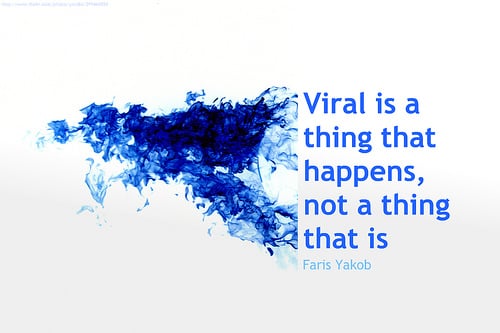
Early Detection: How Social Media May Save The World
The author's views are entirely their own (excluding the unlikely event of hypnosis) and may not always reflect the views of Moz.
It is a typical Tuesday afternoon in suburbia California. Jenny, a sixteen year old girl is taking a sick day from school. With a runny nose, she sits idly on her bed surfing Facebook. At the same time, 2,000 miles away in Seattle, a twenty-two year old ambitious college drop-out named Kevin is on Twitter complaining about his sore throat. Meanwhile, on the other side of the world, a 40 year old single mother in London searches Google on her phone for the location of the nearest Boots drug store so she can buy cold medicine.
If a human from 200 years ago were to look at our planet today, it would appear completely alien. Culture shifts and technology improvements have drastically changed our perceived landscape. One tiny part of this is the use of social media and search engines. More than ever, teenagers are complaining about their parents joining Facebook and parents are complaining about their children interfering with their online social lives. Together they are sharing small events like sore throats, runny noses and big events like floods and hurricanes. Communicating online has become intertwined with our lives and has now become deeply integrated with our work, education and entertainment.
But how did this happen? While I don't know for sure, I do recognize the patterns. For companies like Twitter, Google, Digg and Facebook, it started with a small group of entrepreneurs in California whose great ideas eventually went viral and spread around the globe. This word ‘viral’ describes a pattern and has become a buzzword. It is usually used to describe the virus like spread of ideas and technologies. The amazing idea behind a virus like spread is it expands exponentially. Once it starts, it multiples and multiples until nothing can stop it.
It is the great irony I see in this buzzward that prompted this post. I believe the viral nature of social media and popular technology companies is what will paradoxically allow us to prevent the viral spread of real viruses and pandemics. This is not a new idea. Many vaccines are in essence inert viruses fighting would-be viruses.
In 2006, a man by the name of Dr. Larry Brilliant won the TED prize for calling for a new global system that could identify pandemics before they spread. Dr. Brilliant (you can’t make this stuff up) is world renowned for his efforts in successfully eradicating smallpox from the planet. Before winning the TED prize, he had been inspired by the potential of a Canadian system called GPHIN. GPHIN is a system of web crawlers and analyzers that scour web based content looking for trends in keywords like ‘fever’, ‘cough’, ‘tired’, ‘sick’ and ‘flu’. Using this methodology, GPHIN was able to detect a would-be SARS outbreak six weeks before any other system (including the systems used by the World Health Organization). Quick responding officials were able to isolate the outbreak and prevent a global pandemic. Dr. Brilliant later said that this possible for two reasons.
Unfortunately, this is not where the story ends. Larry Brilliant has since left Google for other endeavors. GPHIN and Google Flu Trends continue to save lives but they are only the tip of the iceberg. Google is now falling behind new competitors that dominate the ever growing real-time web. Status updates from Twitter and Facebook are being produced and becoming obsolete so quickly that Google’s index can’t keep up. We saw this with Michael Jackson’s death and we will see it again in the future.
Social media has the potential to become the greatest early detection system that the world has ever seen. It is faster, nimbler and has more access to user data than any traditional search engine. Not only does Facebook have the data necessary to see who is suffering from an illness, it has the data necessary to predict who these ill people will most likely come in contact with. Twitter has the data to make similar predictions (although less accurately because people don’t physically spend time with Twitter friends like they do with Facebook friends) but enjoys the added benefit of being accessed and updated from any place with mobile phone or WIFI service. (90% of Twitter requests are made to it's API, whereas only 12% of Facebook users access Facebook through it's mobile apps).
These two social media platforms by themselves have the ability to enable ordinary people to report their symptoms in real-time. Specialists like epidemiologists and statisticians could then identify threats (early detection) and use these same communication channels to direct aid workers (rapid response) on how best to isolate viruses before they become pandemics. If the features of other social media platforms and modern search engines were added to this theoretical system, specialists could for the first time ever educate the global community in real time. (Think about how many people read stories on Digg or about the much larger amount of people who read Google Adsense ads every day.)
Theory and predictions are helpful but just like verbal contracts, they are only worth the paper they are written on. Luckily for us, this theoretical system is already becoming reality today. People are already reporting their symptoms on Twitter and on Facebook. Likewise, disease experts and aid workers are already using social media to organize relief efforts. Although a unified, non-government controlled system for monitoring these platforms doesn't currently exist, all of the pieces are in place. Dr. Brilliant said that there are two steps necessary for preventing pandemics. Social media is completing the first step (early detection) to a degree that even he couldn't imagine. Better still, this is not costing the public a dime.
The world is changing in parallel with the internet. Next time you hear someone complain about "pointless" status updates, take the time to explain it to them. Social media is powered by all of us individually. Because of this, you have the ability to make a positive difference.
UPDATE: There has been some very healthy discussion in the comments that I would like to address here. Thank you 0lly and Bludge for bringing this up.
What about false alarms? Clearly, social media will have a lot of noise mixed in with legitimate concerns. Just like good ideas, bad ideas can spread virally as well. Paranoia and misinformation run rampant in the media and online.
So how do medical professionals use a system that will likely have a lot of misinformation and noise? The key is acknowledging that limitation and designing the system to account for it. The reason that GPHIN was so successful, was not that it sent an e-mail directly to health authorities every time someone mentioned "cough", instead it was so powerful because it used aggregate information to identify real trends. Real people, including doctors, look over the information and decide if it is worth pursuing or not. It is natural to assume the front end of a system like this might look something Twitter search with has every relevant Tweet visible. This is not how it works. Instead I think a more accurate representation would be that of Google Flu Trends (aggregate information) with trends that can be broken down by location and with the help of social media, broken down into social groups.
Other Similar Discussions:
Twitter: Growing Virally But Can It Stop Viruses? - Chris Thorman writes a very compelling post that adds the use of Electronic Medical Records (EMRs) to the discussion. From the article "The combination of social media and EMRs, in some form or another, will undoubtedly be part of the future of tracking disease outbreaks. The how and when of that process remains complicated, dependent on health agencies, governments and the doctors themselves to implement the appropriate systems."
If a human from 200 years ago were to look at our planet today, it would appear completely alien. Culture shifts and technology improvements have drastically changed our perceived landscape. One tiny part of this is the use of social media and search engines. More than ever, teenagers are complaining about their parents joining Facebook and parents are complaining about their children interfering with their online social lives. Together they are sharing small events like sore throats, runny noses and big events like floods and hurricanes. Communicating online has become intertwined with our lives and has now become deeply integrated with our work, education and entertainment.
But how did this happen? While I don't know for sure, I do recognize the patterns. For companies like Twitter, Google, Digg and Facebook, it started with a small group of entrepreneurs in California whose great ideas eventually went viral and spread around the globe. This word ‘viral’ describes a pattern and has become a buzzword. It is usually used to describe the virus like spread of ideas and technologies. The amazing idea behind a virus like spread is it expands exponentially. Once it starts, it multiples and multiples until nothing can stop it.
It is the great irony I see in this buzzward that prompted this post. I believe the viral nature of social media and popular technology companies is what will paradoxically allow us to prevent the viral spread of real viruses and pandemics. This is not a new idea. Many vaccines are in essence inert viruses fighting would-be viruses.
In 2006, a man by the name of Dr. Larry Brilliant won the TED prize for calling for a new global system that could identify pandemics before they spread. Dr. Brilliant (you can’t make this stuff up) is world renowned for his efforts in successfully eradicating smallpox from the planet. Before winning the TED prize, he had been inspired by the potential of a Canadian system called GPHIN. GPHIN is a system of web crawlers and analyzers that scour web based content looking for trends in keywords like ‘fever’, ‘cough’, ‘tired’, ‘sick’ and ‘flu’. Using this methodology, GPHIN was able to detect a would-be SARS outbreak six weeks before any other system (including the systems used by the World Health Organization). Quick responding officials were able to isolate the outbreak and prevent a global pandemic. Dr. Brilliant later said that this possible for two reasons.
- Early Detection
- Rapid Response
Unfortunately, this is not where the story ends. Larry Brilliant has since left Google for other endeavors. GPHIN and Google Flu Trends continue to save lives but they are only the tip of the iceberg. Google is now falling behind new competitors that dominate the ever growing real-time web. Status updates from Twitter and Facebook are being produced and becoming obsolete so quickly that Google’s index can’t keep up. We saw this with Michael Jackson’s death and we will see it again in the future.
Social media has the potential to become the greatest early detection system that the world has ever seen. It is faster, nimbler and has more access to user data than any traditional search engine. Not only does Facebook have the data necessary to see who is suffering from an illness, it has the data necessary to predict who these ill people will most likely come in contact with. Twitter has the data to make similar predictions (although less accurately because people don’t physically spend time with Twitter friends like they do with Facebook friends) but enjoys the added benefit of being accessed and updated from any place with mobile phone or WIFI service. (90% of Twitter requests are made to it's API, whereas only 12% of Facebook users access Facebook through it's mobile apps).
These two social media platforms by themselves have the ability to enable ordinary people to report their symptoms in real-time. Specialists like epidemiologists and statisticians could then identify threats (early detection) and use these same communication channels to direct aid workers (rapid response) on how best to isolate viruses before they become pandemics. If the features of other social media platforms and modern search engines were added to this theoretical system, specialists could for the first time ever educate the global community in real time. (Think about how many people read stories on Digg or about the much larger amount of people who read Google Adsense ads every day.)
Theory and predictions are helpful but just like verbal contracts, they are only worth the paper they are written on. Luckily for us, this theoretical system is already becoming reality today. People are already reporting their symptoms on Twitter and on Facebook. Likewise, disease experts and aid workers are already using social media to organize relief efforts. Although a unified, non-government controlled system for monitoring these platforms doesn't currently exist, all of the pieces are in place. Dr. Brilliant said that there are two steps necessary for preventing pandemics. Social media is completing the first step (early detection) to a degree that even he couldn't imagine. Better still, this is not costing the public a dime.
The world is changing in parallel with the internet. Next time you hear someone complain about "pointless" status updates, take the time to explain it to them. Social media is powered by all of us individually. Because of this, you have the ability to make a positive difference.
UPDATE: There has been some very healthy discussion in the comments that I would like to address here. Thank you 0lly and Bludge for bringing this up.
What about false alarms? Clearly, social media will have a lot of noise mixed in with legitimate concerns. Just like good ideas, bad ideas can spread virally as well. Paranoia and misinformation run rampant in the media and online.
So how do medical professionals use a system that will likely have a lot of misinformation and noise? The key is acknowledging that limitation and designing the system to account for it. The reason that GPHIN was so successful, was not that it sent an e-mail directly to health authorities every time someone mentioned "cough", instead it was so powerful because it used aggregate information to identify real trends. Real people, including doctors, look over the information and decide if it is worth pursuing or not. It is natural to assume the front end of a system like this might look something Twitter search with has every relevant Tweet visible. This is not how it works. Instead I think a more accurate representation would be that of Google Flu Trends (aggregate information) with trends that can be broken down by location and with the help of social media, broken down into social groups.
I am not and do not claim to be a medical or disease expert. If you are, I invite you to help me make this post better. As always, feel free to leave your thoughts in the comments below. If you would rather not do that, feel free to e-mail me. All of my contact information is available on my profile: Danny Thanks!
Other Similar Discussions:
Twitter: Growing Virally But Can It Stop Viruses? - Chris Thorman writes a very compelling post that adds the use of Electronic Medical Records (EMRs) to the discussion. From the article "The combination of social media and EMRs, in some form or another, will undoubtedly be part of the future of tracking disease outbreaks. The how and when of that process remains complicated, dependent on health agencies, governments and the doctors themselves to implement the appropriate systems."







Comments
Please keep your comments TAGFEE by following the community etiquette
Comments are closed. Got a burning question? Head to our Q&A section to start a new conversation.